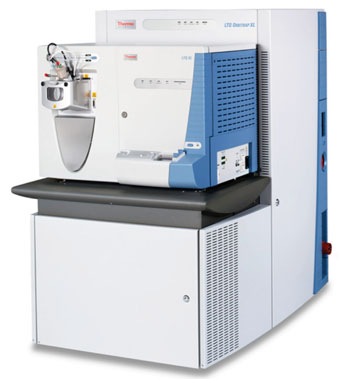Proteomic Methods Diagnose Pancreatic Cancer
By LabMedica International staff writers
Posted on 08 Apr 2014
A method has been developed that identifies pancreatic cancer's visible precursors with 97% certainty, and is expected to aid in the early discovery of the cancer as well as minimize the risk of unnecessary surgery. Posted on 08 Apr 2014
The poor prognosis for pancreatic cancer, is due to the fact that the tumors often develop unnoticed, and rarely causes symptoms until they have spread to other organs, however fluid-filled compartments in the pancreas, called cysts, may be precursors of the cancer.

Image: The LTQ-FT Orbitrap XL Hybrid Ion Trap Mass Spectrometer (Photo courtesy of Thermo Scientific).
Scientists at the Sahlgrenska University Hospital (Gothenburg, Sweden) evaluated whether cyst fluid mucin expression could predict malignant potential and/or transformation in pancreatic cystic lesions (PCLs). A proteomic method was devised and prospectively evaluated in consecutive patients referred to a tertiary center for endoscopic ultrasound-guided aspiration of cystic lesions from May 2007 through November 2008 (discovery cohort) and from December 2008 through October 2012 (validation cohort).
Cytology and cyst fluid carcinoembryonic antigen (CEA; premalignancy greater than 192 ng/mL, malignancy greater than 1,000 ng/mL) were routinely analyzed. Samples were further processed as follows: one-dimensional gel electrophoresis, excision of high-mass areas, tryptic digestion and nanoliquid chromatography–tandem mass spectrometry, with peptide identification. Peptides were separated on a reversed column coupled to a hybrid linear ion trap-Fourier transform ion cyclotron resonance mass spectrometry instrument equipped with a 7-tesla magnet (LTQ-FT; Thermo Electron; Bremen, Germany).
Proteomic mucin profiling proved statistically significantly more accurate at 97.5%; than cytology at 71.4%, and cyst fluid CEA at 78.0% in identifying the 37/79 (46.8%) lesions with malignant potential, either premalignant or malignant tumors. The accuracy of proteomics was nearly identical, 96.6% versus 98.0%, between the 29 patients in the discovery and 50 patients in the validation cohorts. Furthermore, mucin profiling predicted malignant transformation, present in 16/29 lesions with available histology, with 89.7% accuracy.
Karolina Sjöberg Jabbar, MD, the corresponding author of the study said, “This is an exceptionally good result for a diagnostic test, and we are very hopeful that the method will enable more instances of early discovery of pancreatic cancer, at a stage when the cancer can be treated or prevented. This approach may also minimize the risk of unnecessary operations on nonmalignant cysts.” The study was published in the March 2014 issue of the Journal of the National Cancer Institute.
Related Links:
Sahlgrenska University Hospital
Thermo Electron














